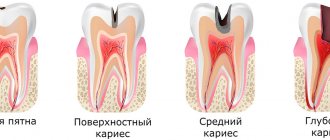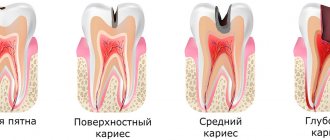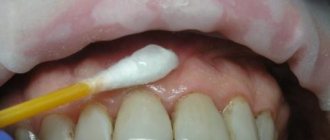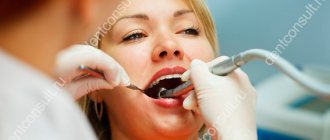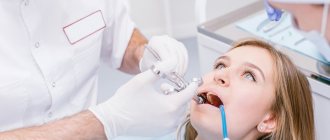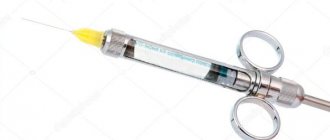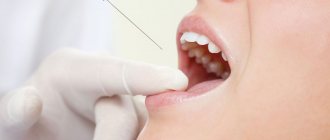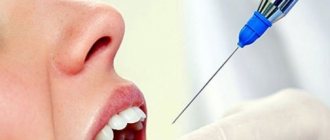Anesthesia without adrenaline has been used in dentistry for quite a long time; it allows painless treatment even for those patients who have contraindications to common means of local anesthesia. Typically, drugs that do not contain adrenaline are used in cases where it is necessary to treat teeth in patients with high blood pressure, heart disease, and pregnant or breastfeeding women.
What is Articaine and what is its composition?
Articaine is an amide anesthetic intended for local, infiltrative or conductive anesthesia for both simple and complex dental procedures. A local anesthetic blocks the generation and conduction of nerve impulses, presumably by increasing the threshold of electrical excitation in the nerve, slowing the propagation of the nerve impulse, and decreasing the rate of rise of the action potential.
The uniqueness of Articaine as a member of the amide family is that it contains an ester group and a thiophene instead of a benzene ring. The thiophene ring increases the lipid solubility of articaine, facilitating more efficient diffusion of the anesthetic across the lipid membrane of nerve cells into surrounding tissues. Articaine is widely used in dentistry due to its safety during short procedures that require rapid onset of anesthesia.
The onset of action of the drug Articaine is:
- from 1.5 to 1.8 min. with infiltration of the upper jaw;
- from 1.5 to 3.6 min. with block anesthesia of the lower jaw.
Articaine pulp anesthesia lasts from 30 to 120 minutes. Anesthesia of soft tissues with the drug lasts ~ 2.25 hours for infiltration of the upper jaw, 4 hours for blockade of the lower jaw.
The drug is produced in the form of an injection solution - a transparent, colorless or yellowish liquid. For retail sale to pharmacy chains, Articaine is supplied in ampoules made of colorless chemically pure glass, enclosed in blister packs and/or cardboard packs.
Composition of articaine in dentistry:
- active agent - articaine hydrochloride;
- Excipients: sodium chloride (to make the solution isotonic) and distilled water.
1 ml of solution contains 40 mg of active agent.
In odonto-dental anesthesia, articaine is used alone or in combination with epinephrine (adrenaline). Epinephrine, diluted to 1:100,000 or 1:200,000 and added to the solution, slows down the passage of articaine into the general bloodstream and thus ensures long-term maintenance of the concentration of the active substance in the tissues, allowing a small hemorrhagic surgical field to be obtained.
It is possible to replace Articaine with synonyms with the same active substance, such as:
- Artikain-Binergy;
- Ultracaine;
- Artikain-DF;
- Articaine with Epinephrine.
The decision to use analogues is made by the attending physician, taking into account the individual characteristics of the patient.
Local anesthetics in dentistry
Anesthetics based on Articaine are the most modern in dentistry. Anesthetics of the articaine series are Ultracaine, Ubistezin, Septanest, etc. The effectiveness of these anesthetics is much higher than that of Lidocaine or Novocaine. And Novocain has practically no effect in anesthetizing the area of inflammation.
In addition, most articaine anesthetics contain vasoconstrictors (adrenaline or epinephrine), which reduce the leaching of the anesthetic, which has a positive effect on the duration and active effect of anesthesia.
Ultracaine
– local anesthetic for infiltration and conduction anesthesia in dentistry and during operations on the oral cavity, has a pronounced local anesthetic effect. The active ingredient is articaine hydrochloride + adrenaline hydrotartrate (epinephrine). The onset of action is immediately after administration. Duration of action – from 1 to 3 hours
Advantages:
- Reliable anesthetic effect - 99% of cases of successful anesthesia
- Proven safety - 0.6% adverse events
- Possibility of use in children, pregnant women, elderly patients
Available in three versions, which differ in the content of epinephrine in its composition.
- Ultracaine DS forte (epinephrine content in solution 1:200,000)
- Ultracaine DS (epinephrine content in solution 1:100,000)
- Ultracaine D (without epinephrine and preservatives)
Ubistezin
– local anesthetic for infiltration and conduction anesthesia for wide application in dentistry. Suitable for standard types of surgical interventions during short procedures. The composition of Ubistezin is no different from the same forms of Ultracain.
Advantages:
- Suitable for adults and children over 4 years of age
- Average duration of action: 45 minutes for intrapulpal anesthesia, 120-240 minutes for soft tissue anesthesia
- The onset of the anesthetic effect is 1-3 minutes after administration.
Available in two versions, which differ in the content of epinephrine in its composition.
- Ubistezin (epinephrine content in solution 1:200,000)
- Ubistezin forte (epinephrine content in solution 1:100,000)
Septanest
– a preparation for local anesthesia based on articaine for use in dentistry. Unlike the first two anesthetics, it contains preservatives such as sodium metabisulfite and ethylenediaminetetraacetate, which have a powerful allergenic effect.
Available in two versions, which differ in the content of epinephrine in its composition.
- Septanest (epinephrine content in solution 1:200,000)
- Septanest (epinephrine content in solution 1:100,000)
Scandonest
– an anesthetic without a vasoconstrictor component. Suitable for adults and children. The onset of the anesthetic effect is 1 to 3 minutes after administration.
Indications for use:
- Anesthesia for simple tooth extraction, tooth preparation
- Ideal for treating patients with contraindications to vasoconstrictor supplements, especially for patients with cardiovascular disease
Advantages of the drug Skandonest:
- Contains 3% mepivacaine
Does not contain other additives and epiniphrine, therefore, it is suitable specifically for patients suffering from cardiovascular pathology and who have contraindications to vasoconstrictor supplements
Read on topic: Removal and treatment of teeth during sleep (sedation)
Manufacturers Articaine
On the Russian pharmaceutical market, the anesthetic Articaine and its analogues are represented by domestic and foreign manufacturers. You can buy articaine in St. Petersburg and Moscow using the link.
The products of the following enterprises are most in demand:
- JSC "Biokhimik" (Russia);
- CJSC "Binergy" (Russia);
- LABORATORY INIBSA, SA (Spain);
- Welfarm LLC (Russia);
- Armavir biofactory FKP (Russia);
- Borisov Medical Preparations Plant (Republic of Belarus);
- Sanofi-Aventis Deutschland GmbH (Germany).
Preparations based on articaine, created at different enterprises, may have certain differences due to production technology, quantitative and qualitative composition of excipients, but at the same time retain the main direction of action of the active substance.
Choosing anesthesia in dentistry
The relevance of the problem of a dentist choosing a local anesthetic is confirmed by the fact that, as a rule, a multicomponent compound enters the internal environment of the patient’s body during local anesthesia. Thus, ingestion of catecholamines, which are used as vasoconstrictors, can lead to increased blood pressure and heart rate, hyperglycemia and other undesirable consequences (A. Zh. Petrikas et al., 1997; Yu. F. Krylov et al., 2000; S. Malamed, 2000). Various components of a local anesthetic drug can be very dangerous in patients at risk (E. V. Zoryan et al., 1997; V. I. Stosh et al., 1998; P. I. Ivasenko et al., 2000). This factor is of particular importance in light of the results of a survey conducted by employees of the Department of Therapeutic Dentistry of St. Petersburg State Medical University named after. acad. I. P. Pavlova: about 68% of the 406 dental patients surveyed at the city dental clinic could be classified as high-risk patients. Stabilizers and preservatives are often the causes of allergic reactions in patients (P. I. Ivasenko et al., 2004). At the same time, our oral surveys and questionnaires among dentists show clearly insufficient knowledge regarding the following points:
Components of a local anesthetic drug most often used by a dentist.
The influence of various components included in anesthetics on the somatic status of the patient.
Risk groups in relation to local anesthetic drugs.
Age restrictions on the use of drugs stated by manufacturers.
Restrictions (contraindications) stated by manufacturers of anesthetics.
Poor knowledge regarding the composition of local anesthetics, risk groups and contraindications is aggravated by the rare aspiration test and rapid (carpule in 10–15 seconds) administration of the drug. Some doctors simply do not know about the existence of such carpule syringes and carpules that allow them to perform an aspiration test. These factors together determine a fairly high incidence of somatic complications during local anesthesia.
Next, we will consider an algorithm for the safe selection of a local anesthetic, provide data that allows you to choose an anesthetic in relation to various risk groups, and give recommendations for a minimum set of various drugs “for all occasions.”
Algorithm for safe selection of local anesthetic.
Duration, type of planned intervention. This factor influences the doctor’s choice of anesthetic, based on the concentration of the vasoconstrictor in the anesthesia, which will determine the duration of anesthesia. In addition, according to a large number of dentists, anesthesia without a vasoconstrictor has a less effective analgesic effect. At the same time, there is a fairly rational recommendation to add an anesthetic, naturally, taking into account its maximum therapeutic concentration. Following this recommendation leads to improved pain relief. Considering the difference in the concentration of epinephrine (its absence), the choice can be made from the following drugs: ubistezin forte, ubistezin, ultracaine DS, mepivastezin.
Accompanying illnesses.
The most “dangerous” from the point of view of urgent conditions are patients of the following risk groups: heart disease, vascular disease, arterial hypertension, central nervous system diseases, liver and kidney diseases, glaucoma. Particular attention should be paid to decompensated forms of any disease. Epinephrine as part of local anesthesia is, as a rule, contraindicated in such patients. We discuss in detail how a dentist can determine the stage of a patient’s somatic disease in classes with dentists, and information about this was in previous publications. Anesthetics that meet the safety requirement for a minimum concentration of epinephrine or its complete absence: ubistezin, septanest, ultracaine DS, ultracaine D, mepivastezin. It is advisable to remember that mepivastezin, having mepivacaine as its main active principle, independently has a vasoconstrictor effect without vasopressors.
Anesthetic tolerance.
Patients often know which drug they tolerate best. Without going into detail about the placebo effect, it makes sense to take this information into account when choosing a drug. In addition, for some patients the dose is a significant factor. They can react “toxically” to a therapeutic dose even without the drug entering the vessel.
Allergy.
By specifically distinguishing allergies from concomitant diseases, we draw attention to the fact that patients often do not consider allergies to be a disease. And thus, during an oral interview, they can mislead the doctor about the presence of allergic diseases. Let's take into account two factors:
1. Allergies often develop not to the anesthetic itself, but to its components (preservatives and stabilizers);
2. Allergization of the population exists and is growing due to the consumption of foods and the use of medications containing preservatives and stabilizers. We can conclude: the fewer parabens, sulfites and editic acid in the local anesthetic, the less likely it is to cause an allergic reaction in the patient. This recommendation is best met by the drugs ubistezin, ubistezin forte, ultracaine D, and mepivastezin. Carpules with a protective film (ubistezin) guarantee greater safety of the drug, therefore editic acid, one of the components that causes allergic reactions, was removed from such carpules.
Hypoproteinemia.
It is known that the more a drug binds to proteins, the less systemic toxicity it has. At the same time, patients with hypoproteinemia of any origin are at risk for systemic reactions. Consequently, drugs based on articaine (ubistezin, septanest, ultracaine) are the drugs of choice in this case.
Pregnancy and lactation.
Preparations of the articaine group, officially being the least toxic, are recommended for use in pregnant women. It is also possible to use them during lactation. You should carefully read the instructions for the drug and if there are instructions that the drug should be used with caution in pregnant women, perform anesthesia with caution, that is, do an aspiration test, administer the drug fractionally (in 3 doses) and slowly, carpule in 1 minute. Group of drugs of choice: ubistezin, ultracaine, septanest. It is imperative to take into account the recommendation of obstetricians and gynecologists to treat pregnant women only in the second trimester and, preferably, preventive treatment of women planning a pregnancy.
Taking medications.
There are strict contraindications for combining certain drugs with epinephrine as part of local anesthesia: cardiac glycosides (for example, digoxin): non-selective beta blockers (for example, anaprilin), MAO inhibitors (for example, aminazine). A local anesthetic with low epinephrine content should be used with caution in patients taking ACE inhibitors (for example, Enap), clonidine, rauwolfia preparations, thyroid hormones. Group of choice of local anesthetics: mepivastezin, ultracaine D, ubistezin, ultracaine, septanest. Some medications have a toxic effect on the liver and worsen kidney function. This factor is discussed below.
Pseudocholinesterase deficiency.
Essential local anesthetics are inactivated in the bloodstream by the enzyme pseudocholinesterase. Thus, this pathology is a contraindication for the use of ether anesthetics. Its most significant manifestation is muscle weakness.
Pathology of the liver, kidneys.
Local anesthetic drugs can have a toxic effect if the metabolic and excretory systems are insufficient. Amide anesthetics are metabolized in the liver. A small amount (no more than 10%) of both amide and ether local anesthetics is excreted unchanged by the kidneys. Thus, relative contraindications to the use of amide anesthetics are liver diseases, ether ones are deficiency of plasma pseudocholinesterase, and for all local anesthetics - kidney diseases. Local anesthesia should also be used with caution if the patient is using therapy that worsens liver or kidney function (chemotherapy, certain types of antibiotics, antifungal drugs, etc.). Group of drugs of choice: ubistezin, septanest, ultracaine. It is necessary to use smaller doses, do an aspiration test, and administer the drug slowly, in three doses.
Patient age
For children under 14 years of age and adults over 70 years of age, the minimum toxic doses of all local anesthetics are less than for patients of the average age group. The maximum possible doses of drugs should be strictly observed: lidocaine - the maximum dose is 1.33 mg of the drug per 1 kg of the child’s weight; mepivacaine - maximum dose of 1.33 mg of the drug per 1 kg of child’s weight; articaine - maximum dose of 7 mg of the drug per 1 kg of child’s weight.
The use of articaine is contraindicated in children under 4 years of age.
Adults over 70–75 years of age should be treated like children from the point of view of maximum doses and at the same time be guided either by the actual body weight or by 70 kg if the actual one exceeds that.
Fear of local anesthesia (syringe phobia), dental phobia.
It is believed that the patient's stress during a dental appointment leads to such a release of the patient's own adrenaline that the adrenaline of the local anesthetic can be considered a drop in the ocean. In terms of pure numbers, this is true. However, under conditions of stress, the patient’s body finds itself in conditions of so-called unstable disequilibrium, when the last drop is enough for the “cup to overflow.” In the case of a clear stress reaction of the patient, all possible methods should be used, from drug premedication and beliefs based on logic to elements of conversational hypnosis. The anesthetics of choice are drugs with low or no epinephrine content (ubistezin, ultracaine DS, mepivastezin).
Psychological status of the patient.
The unsatisfactory psychological state of the patient (manifestations of depression, emotional lability, tearfulness), known negative facts of the patient’s personal or social life are exactly the same stress factor as dental phobia.
Reliability of the company - manufacturer and supplier of medicines.
GMP standards in production, guarantee against counterfeiting, guarantee of correct storage and delivery conditions.
Thus, summing up the results of the prevention of emergency conditions using the correct choice of anesthetic, we can once again emphasize how important it is for the dentist to collect the most complete information about both the patient’s somatic status and his psychological status. Draw correct conclusions about all possible risk factors. It is good to know the drugs the doctor uses. Have a sufficient selection of them (available “for all occasions”: ubistezin forte, ubistezin, mepivastezin, ultracaine DS). Carry out anesthesia, observing all precautions (amperation test, slow injection, fractional injection). Conduct psychological preparation and accompaniment of the patient.
Dentist at the 4th city clinic in Minsk
Kudrevich N.I.
Articaine: side effects
Such qualities of Artican as low fat solubility, high% binding to blood proteins, low half-life ensure low toxicity of the drug. However, depending on the general condition, age, individual reactions of the patient and his existing systemic diseases, side effects may be observed during anesthesia with the drug, such as:
- disturbance or confusion;
- vertigo;
- headache;
- nausea;
- dyspnea;
- decreased blood pressure;
- diplopia;
- muscle tremors;
- allergic and local reactions, manifested in symptoms of urticaria, conjunctivitis, rhinitis, skin hyperemia, swelling and inflammation at the injection site.
Articaine should be used with caution during dental procedures in patients with impaired cardiovascular function, vascular diseases, liver and kidney failure.
Which anesthetic should I choose?
- For bronchial asthma or high allergies, it is best to choose an anesthetic without preservatives, for example Ultracaine D.
- For thyroid diseases and diabetes mellitus, you should use anesthetics that do not contain vasoconstrictor components - Ultracain D or Scandonest.
- For high blood pressure and heart disease, anesthetics with an epinephrine concentration of 1:200,000 are chosen - Ultracain DS, Ubistezin. For decompensated heart diseases and severe hypertension, anesthetics that do not contain epinephrine and adrenaline should be used - Ultracaine D.
- In the absence of the above diseases, you can use anesthetics with an epinephrine concentration of 1:100,000 - Ultracain DS forte, Ubistezin forte.
- During pregnancy and breastfeeding, anesthetics with an epinephrine concentration of 1:200,000 are chosen - Ultracain DS, Ubistezin. This concentration does not affect the fetus and is not detected in breast milk.
Articaine during pregnancy in dentistry
Articaine is usually well tolerated at all stages of pregnancy. There is no data on the long-term effects of the drug on the neurophysiology of the newborn. Also, no teratogenic damage was observed after use of the drug in the first trimester.
There are no data from clinical studies of the penetration of Articaine into breast milk. To minimize possible risk to the baby, breastfeeding mothers may choose to express milk for approximately 4 hours after the injection. After which breastfeeding can be resumed.
Artikain
Articaine is a local anesthetic. It acts by stabilizing neuronal membranes, preventing the generation and propagation of a nerve impulse. It is used for infiltration (when the area of branching of nerve endings is anesthetized) and conduction (when a large nerve trunk is blocked) anesthesia during surgical interventions and diagnostic procedures. Widely used in dentistry. As you know, most dental procedures are accompanied by pain of varying degrees, and only adequate anesthesia can prevent the patient from developing a full-fledged phobia about visiting the dentist. Currently, the most effective and safe method of pain control in dentistry is local anesthesia, which is used in 98% of interventions. Articaine was synthesized in the late 1970s. To this day, it remains one of the most effective local anesthetics. One of its key advantages is its relatively short (about 30 minutes) half-life and a large proportion of binding to plasma proteins (up to 95%), i.e. with accidental intravascular administration, the likelihood of causing a toxic effect is minimal. In addition to this, the drug diffuses to the maximum extent into bone and soft tissue, which means it is fast (within 1-11 minutes) and sufficient in duration (60-225 minutes).
) analgesic effect. The dose is determined individually based on the indications and dosage form used. After intramuscular administration, the peak concentration of the active component is recorded in the blood after 20-40 minutes. When passing through the liver it is completely metabolized. It is quickly removed from tissues. Elimination from the body occurs mainly through urine. In case of a lack of the enzyme pseudocholinesterase, neurocirculatory dystonia, lesions of the central nervous system of various origins, pernicious anemia, conditions of chronic oxygen starvation, articaine is used with extreme caution. It is allowed to combine the drug with adrenaline and glucose. Tricyclic antidepressants (amitriptyline, imipramine, clomipramine, desipramine, etc.) potentiate the antihypertensive effect of articaine. When using the drug in gynecological practice, especially when blocking the paracervical nerve, a decrease in the heart rate of the fetus is possible. Articaine passes into breast milk only in small quantities, so anesthesia using this drug is also possible during breastfeeding. When using articaine, the following side effects may develop: headaches, visual disturbances, shortness of breath, apnea, involuntary trembling of the fingers, convulsions, dyspeptic disorders, decreased blood pressure, allergic manifestations.
Instructions for use
To exclude or minimize intravascular administration of Articaine, an aspiration test is required before using the drug. An accurate and slow technique for injecting the drug is required with control of the pressure on the syringe plunger depending on the sensitization of the tissue.
The instructions for use in dentistry recommend using Articaine in a dosage corresponding to the nature of the manipulation:
- 1.7 ml of solution per tooth for uncomplicated extraction of the upper jaw tooth;
- 0.1 ml for anesthetizing incisions when creating a palatal depot and suturing;
- 0.5-1.7 ml per tooth for grinding teeth for crowns and in case of cavity preparation.
After each injection of Articaine, careful and constant monitoring of vital signs of the cardiovascular and respiratory systems (adequacy of ventilation) and the patient’s state of consciousness should be carried out.
using Articaine in dentistry for infiltration anesthesia during extirpation of mandibular premolars.
Articaine (ultracaine) is a local anesthetic of the amide type of a series of thiophenes. Allergy to this drug is rare and can manifest itself in the form of skin rash, itching around the injection site, rhinitis, and in severe cases, angioedema and anaphylactic shock. Determination of specific immunoglobulin E for a given allergen in increased quantities indicates the presence of sensitization of the body to it.
A drug allergy is a specific reaction of the immune system to drugs.
Drug allergies can occur as a complication during the treatment of the underlying disease or as a result of prolonged contact with medications (by doctors, healthcare workers, pharmacists). The main reasons for the development of allergies to drugs are hereditary factors, the presence of other types of allergies, long-term use of drugs, simultaneous use of a large number of different drugs, overdose (in this case we are talking about a pseudo-allergic reaction). An allergic reaction can be provoked by any medications, but the most common allergens are antibiotics, local anesthetics, non-steroidal anti-inflammatory drugs, etc. This type of allergy is characterized by the following symptoms: redness of the skin, itching, various types of skin rashes, year-round conjunctivitis. Allergic reactions to medications develop from a few seconds to several hours and can cause an attack of bronchial asthma, urticaria, Quincke's edema, allergic rhinitis or anaphylactic shock. If you have an allergy to a certain medicine, it should be taken into account that it can also occur when using medicines with a similar composition.
The study is carried out only for type 1 allergic reactions. A negative test result cannot guarantee that you will not have another type of allergic reaction.
Synonyms Russian
Specific immunoglobulins of class E to articaine (ultracaine).
English synonyms
Allergen c68 – Articaine/Ultracaine; IgE.
Research method
Enzyme-linked immunosorbent assay (ELISA).
Units
IU/ml (international unit per milliliter).
What biomaterial can be used for research?
Venous blood.
How to properly prepare for research?
- Do not smoke for 30 minutes before the test.
General information about the study
Articaine is the international name for an amide-type local anesthetic, widely distributed under the following trade names: Ultracaine, Ultracaine D-S, Ultracaine D-S forte, Alfacain, Ubistezin, Primacaine.
The drug is used for infiltration and conduction anesthesia, most often in dental practice. The anesthetic enters the nerve fiber cells, where it blocks the entry of sodium ions, thereby temporarily stopping the conduction of the nerve impulse. Articaine is a local anesthetic with a fairly strong anesthetic effect; the effect occurs almost immediately after administration and lasts up to several hours.
One of the side effects of using articaine is the development of an allergic reaction in sensitized individuals, which occurs quite rarely, but can lead to serious consequences. The reaction develops as an immediate type of hypersensitivity - within a few minutes or hours. As a rule, a mild form of allergy occurs with the appearance of hyperemia or urticaria, itching at the injection site, and allergic dermatitis. In more severe cases, allergic rhinitis and conjunctivitis, and bronchial asthma develop. The most severe manifestations are angioedema (Quincke's edema) and anaphylactic shock, involving the vital cardiovascular and respiratory systems in the process, which requires urgent medical intervention.
What is the research used for?
- Diagnosis of immediate allergic reactions to articaine/ultracaine;
- differential diagnosis of the causes of allergic reactions in children and adults during the use of local anesthetics.
When is the study scheduled?
- When planning local anesthesia with articaine/ultracaine in patients with suspected allergies to local anesthetics;
- when examining children and adults with urticaria, itching, allergic rhinitis, conjunctivitis, bronchial asthma, angioedema, anaphylactic shock after the use of local anesthetics.
What do the results mean?
Reference values: 0.00 - 0.35 IU/ml.
Reasons for the positive result:
- immediate hypersensitivity to articaine/ultracaine.
Reasons for negative results:
- lack of IgE sensitization to this allergen;
- long-term restriction or exclusion of contact with the allergen.
- successful implementation of ASIT.
Articaine in pediatric dentistry
The pharmacodynamics of local anesthetics in children is comparable to that in adults. In pediatric dental practice, extreme caution must be exercised when using amide local anesthetics as lower intrinsic clearance or decreased serum protein binding may easily lead to an increased risk of toxic reactions. The route of administration is one of the main safety factors when using local anesthetics in neonates and children.
Anesthesia in dentistry with the drug Articaine , carried out using intraosseous injection, is effective in achieving deep anesthesia of teeth affected by MIG with hypersensitivity associated with chronic inflammation of the pulp in children.
In pediatric dentistry, it is recommended to use Articaine 2% due to the lower Cmax and shorter half-life of the drug.
Anesthesia with adrenaline. Why is it used in dentistry?
Anesthesia with adrenaline. Why is it used in dentistry?
Modern dentistry involves pain-free dental treatment. To do this, local anesthesia is used - an injection into the gum next to the tooth in order to temporarily “turn off” the transmission of nerve impulses from the tooth to the brain along the nerve fibers. For this, local anesthetics are used - and if previously it was novocaine or lidocaine, now preference is given to the latest generation drugs - articaine and mepivacaine (they are safer, have fewer side effects, and the risk of developing an allergy to these drugs is much lower).
The anesthetic is injected into the soft tissue of the gums, where a “depot” is created from a substance that works for a certain time. From this “depot” the drug gradually seeps into the blood vessels and is washed out with the bloodstream. In order for this resorption of the anesthetic to proceed more slowly and the anesthesia to work longer, the anesthesia drug contains not only the active substance itself, but also a very small amount of adrenaline - adrenaline has a powerful vasoconstrictor effect, it causes a narrowing of the lumen of the capillaries in the gum, thereby slowing down resorption of the injected anesthetic and increases the duration of anesthesia.
In addition, due to the constriction of blood vessels in the anesthesia zone, provided by adrenaline,
the bleeding of the tissues surrounding the tooth is reduced
, which is especially important during surgical procedures, for example, during tooth extraction.
Different anesthetic drugs contain different amounts of adrenaline (epinephrine). The choice of drug depends on the dental procedure being performed, the age of the patient and the presence of chronic diseases. So, for example, if you plan to treat minor caries, then choose a drug with a low adrenaline content. If it is necessary to remove a tooth or install an implant, then an anesthetic is used, which contains more adrenaline.
A side effect of adrenaline can be increased blood pressure and increased heart rate. In elderly patients, people with diseases of the cardiovascular system, children and other groups of patients, if there are contraindications, anesthesia with minimal or no adrenaline can be used. In this case, the choice is a drug with the anesthetic mepivacaine, and not with articaine, because Mepivacaine itself has a slight vasoconstrictor effect.
Therefore, before starting any dental procedure, in order to choose the right drug, it is so important to inform the doctor about all existing diseases and conditions, about your health and reactions to anesthesia in the past.
Reviews from dentists about the drug Articaine
Most practicing dentists consider Articaine to be the best representative of local anesthetics due to its high effectiveness. At the same time, when using the medication, there is a low incidence of allergic reactions, the possibility of safe use in pregnant women, and the absence of addiction. The only small drawback of Articaine, according to experts, is the inability to prescribe it to children under 4 years of age. In all other cases, Articaine is rightly called one of the drugs of choice.
This information is intended for medical professionals and specialists.
